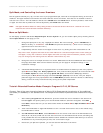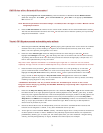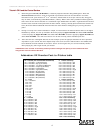
OASYS CX-3 Modeled Tonewheel Organ Guided Tour
4
T
T
u
u
t
t
o
o
r
r
i
i
a
a
l
l
:
:
C
C
X
X
-
-
3
3
a
a
n
n
d
d
t
t
h
h
e
e
C
C
o
o
n
n
t
t
r
r
o
o
l
l
S
S
u
u
r
r
f
f
a
a
c
c
e
e
4. Select Program U-F-043, GP NicePerc, created by keyboard maestro Greg Phillinganes > Press the
Control Surface tab button
> Look at the wealth of parameters that can be controlled in real time:
Percussion on/off, plus choice of 2
nd
or 3
rd
harmonic; Vibrato/Chorus on/off per manual; EQ; Amp gain;
Key On Click; and something called Wheel Brake. (History: Before there were pitchbend wheels/joysticks,
there were the two motor switches on a tonewheel organ labeled Start and Run; organists discovered that
the Run status could be interrupted with the Start switch, causing a steady pitch fall while the switch was
held.) Press the Switch labeled 6/14 and mimic this effect without endangering any moving electrical
parts!
5. During our study of the Lower Drawbars in a Split, we learned that the Control Surface links to the Upper
Drawbars by default, but not by limitation! Press the popup by Upper DrawB6 and select Lowr DrawB1
> Press the popup by Upper DrawB7 and select Lowr DrawB2 > Press the popup by Upper DrawB8 and
select Lowr DrawB3
> You now have control over all the currently active drawbars plus one!
6. There are still four unassigned switches in this example: press the popups and add even more personal
expression to your sound! This Tone Adjust setup is the same for all the CX3 sounds in the OASYS, with
the traditional controls available in the same “areas” as the original. So you can feel instantly familiar
when playing any CX-3 organ sound you choose!
OASYS offers the utmost in flexibility and expression through the quality of its models and their
integration with the Control Surface.
Addendum: EX Drawbar Feet-to-Pitches table
16’ = note 8vb (one octave below fundamental)
16’+1 = note 8vb + ½ step (M7 below)
16’+2 = note 8vb + step up (m7 below)
16’+3 = note 8vb + 11/2 steps up (M6 below)
16’+4 = note 8vb + 2 steps up (m6 below)
16’+5 = note 8vb + P4 (P5 below)
16’+6 = note 8vb + aug4 (tritone below)
8’-5 = note 8vb + P5 (P4 below)
8’-4 = note 8vb + m6 (M3 below)
8’-3 = note 8vb + M6 (m3 below)
8’-2 = note 8vb + m7 (M2 below)
8’-1 = note 8vb + M7 (m2 below)
8’ = note
8’+1 = m2 above
8’+2 = M2
8’+3 = m3
8’+4 = M3
8’+5 = P4
8’+6 = aug4
4’-5 = P5
4’-4 = m6
4’-3 = M6
4’-2 = m7
4’-1 = M7
4’ = note 8va
4’+1 = note 8va + m2
4’+2 = note 8va + M2
4’+3 = note 8va + m3
4’+4 = note 8va + M3
4’+5 = note 8va + P4
4’+6 = note 8va + aug4
2’-5 = note 8va + P5
2’-4 = note 8va + m6
2’-3 = note 8va + M6
2’-2 = note 8va + m7
2’ -1 = note 8va + M7
2’ = note 2 octaves up
2’+1 = note 2 oct’s up + m2
2’+2 = note 2 oct’s up + M2
2’+3 = note 2 oct’s up + m3
2’+4 = note 2 oct’s up + M3
2’+5 = note 2 oct’s up + P4
2’+6 = note 2 oct’s up + aug4
1’-5 = note 2 oct’s up + P5
1’-4 = note 2 oct’s up + m6
1’-3 = note 2 oct’s up + M6
1’-2 = note 2 oct’s up + m7
1’-1 = note 2 oct’s up + M7
1’ = note 3 octaves up
1’+1 = note 3 oct’s up + m2
1’+2 = note 3 oct’s up + M2
1’+3 = note 3 oct’s up + m3
1’+4 = note 3 oct’s up + M3
1’+5 = note 3 oct’s up + P4
1’+6 = note 3 oct’s up + aug4
1’+7 = note 3 oct’s up + P5
1’+8 = note 3 oct’s up + m6
1’+9 = note 3 oct’s up + M6
1’+10 = note 3 oct’s up + m7
1’+11 = note 3 oct’s up + M7
1’+12 = note 4 octaves up
1’+13 = note 4 oct’s up + m2
1’+14 = note 4 oct’s up + M2
1’+15 = note 4 oct’s up + m3
1’+16= note 4 oct’s up + M3
1’+17 = note 4 oct’s up + P4
1’+18 = note 4 oct’s up + aug4
1’+19 = note 4 oct’s up + P5
1’+20 = note 4 oct’s up + m6
1’+21 = note 4 oct’s up + M6
1’+22 = note 4 oct’s up + m7
1’+23 = note 4 oct’s up + M7
1’+24 = note 5 octaves up






